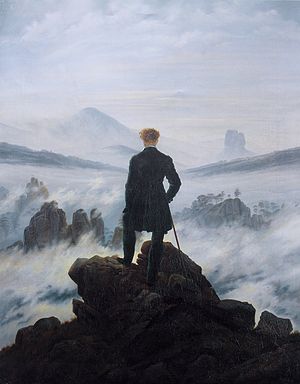| Romanticism |

Caspar David Friedrich, Wanderer Above the Sea of Fog 1818 http://en.wikipedia.org/wiki/Wanderer_above_the_Sea_of_Fog
|
 Caspar David Friedrich, Wanderer Above the Sea of Fog 1818 http://en.wikipedia.org/wiki/Wanderer_above_the_Sea_of_Fog |
|
You’ve heard the term thrown around, and different uses of the word. There are romantic people, Romantic languages, and now we’ll review the Romantic era in history. Understanding the premise of the Romantic thinkers will help us make better sense of a character like Victor Frankenstein and his monster. Romanticism was a very important movement in our history. I believe that many of the sensibilities and values that the Romantics upheld are still present and valued in today’s culture. Here are the points you need to know about Romanticism, many of which were taken from Elements of Literature, fifth course. Romanticism Key Points>Romanticism is the name given to the school of thought that values intuition over reason. >Before the Romantics, we had the Rationalists. The popular way of thinking before the Romantic movement was that the use of reason and logic would lead to the answers we seek. But the Romantics rejected this notion; they accepted that there were questions in the world that could only be answered if we set aside reason and “went with our gut,” or, our intuition. >The Romantics valued imagination. It was in our imaginations that the truths we seek could be found. These imaginations were usually accompanied by powerful emotion, and were paired with pure, natural beauty. >Above all, the Romantics valued individualism and spontaneous action. If you felt a powerful emotion, then you must act on that emotion. >Romantics, like many film-makers and authors today, focused on exotic settings for their literature. These settings typically included a strong sense of nature, away from the dirt and grime of the cities and industrialization. >Their settings were sometimes found in a supernatural realm, or in legends or folklore of the time. >It was popular for the Romantic authors to focus on nature, contemplate it, meditate, until the dull reality of the world fell away, and the beauty and truth of the world was revealed. It is not uncommon for a Romantic poet to be entirely focused on a flower, or a mountain, with a conclusion that includes some sort of insight gained from this flower or mountain. A link below provides further detail on Romanticism, and further in-depth looks at the elements of the movement. Admittedly, it is a bit drab, but the information is summed up nicely, and it is a great resource to keep for your records. The last link below provides a list of common vocabulary that you will come across in Romantic literature. Pick five words from this list, and use them in a sentence. Write these sentences down on your hand-out. “Mont Blanc” by Percy Shelley is an ideal Romantic poem. The central focus of the poem is Mont Blanc itself, which is also a setting in Frankenstein. Exotic? Yes, especially to the blue-collar workers of London and across England. Pure, and natural? You bet. The link to the poem is below. I want you to spend 5 to 10 minutes reviewing the poem, and writing down any lines or phrases from the poem that you think displays one or more of the key points we just reviewed. Cite the line, and briefly (in a sentence or two) explain how this line relates to Romanticism. Here is an example. The opening lines of the poem, “The everlasting universe of things / Flows through the mind, and rolls its rapid waves” suggests that the mind contains the universe and all its truths. This would relate back to the Romantic ideal that it is in ourselves, and our imagination, that the truths of the universe can be found. After you finish with finding a line or phrase in the poem and explaining how that line relates to Romanticism, you have one more task to complete for this web-quest. Thanks for sticking with it! At the top of the page, you will see the famous painting, Wanderer Above a Sea of Fog. This painting is regarded as one of the best examples of Romantic art. Using what we have just reviewed above, you are going to write a short reflection on this painting. What is this man doing on top of this mountain? What is he thinking? More importantly, what is he feeling? How does this painting represent this literary time period? When you finish, turn in the hand-out and any other papers you may have used to continue your responses. Thank you for participating! Keep the link to this web-quest handy, and use it for future review. |
Links: |